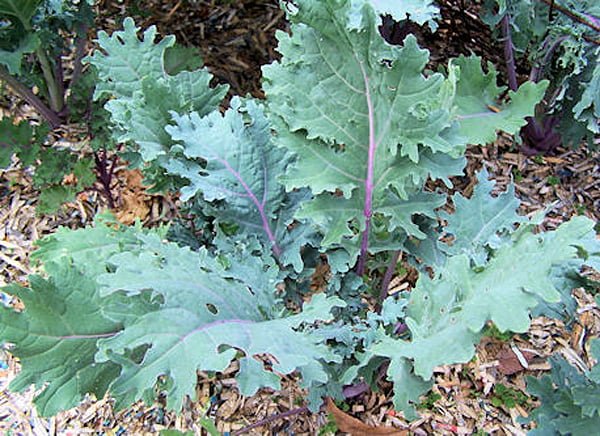Kale or borcole [ Brassica oleracea ] is a versatile member of the cabbage family. It comes in a wide range of leaf shapes and colours, it is a very attractive and hardy vegetable that looks just as good in the flower border as on the vegetable plot. Although kale is usually thought of as a cold weather or winter vegetable, which it is, it can be grown almost all year round. Though in summer it is best grown in partial shade out of direct warm sun.
Soil Preparation.
Like all brassicas, kale grows best in free draining fertile soil. Well rotted manure or garden compost is best added to the bed in the autumn. Brassicas dont like very acidic soil so add lime before planting or do a soil check. A pH of 6.5 – 7.5 is ideal. They also like a firm soil.
Sowing Outside.
Seed can be sown outside from March to May in an seedbed. To prepare the seedbed, work the soil to a fine tilth as soon as it is dry enough. Sow seed thinly in a row and cover with a half inch of fine soil. When the seedlings are 2 -3 inches high, thin to 3 – 4 inches apart. Then when the seedlings are about 6 inches high, they can be transplanted out on the plot into their final growing positions.
Sowing Inside.
Kale can be started at almost anytime if the seeds are sown in modules inside. Fill a module tray with moist compost and sow 1 or 2 seeds into each module section. Cover with a half inch of fine compost or vermiculite. If sowing in winter keep in a warm place or propagator. When seeds have germinated, thin seedlings, leaving one in each module section. Grow on undercover in a greenhouse or cold frame, giving fleece protection in very cold weather. To check if the seedlings need potting on, gently lift the plant from the module to check if the roots have filled the module space. If they have pot on into individual 3 inch pots.
Planting & Growing.
Kale plants, apart from the dwarf varieties can grow quite tall, so remember this when planting out. As a guide the dwarf varieties can be planted around 12 inches apart and the medium and tall varieties need between 18 – 24 inches. When planting the tall varieties, plant deeply right up to the lower leaves and firm in well. Once the plants are settled in to their final positions, they require very little attention. A feed of a high nitrogen fertiliser like chicken pellets, will be appreciated by the plants in spring. If the plants are loosened by winds, firm them back in well and stake if neccesary.
Harvesting.
Harvesting can begin from late summer onwards depending on variety. Just pull off the leaves as required. The plants sometimes produce side shoots, these can be eaten also. Keep picking regularly as this will stimulate the plant to produce more leaves.
Varieties.
Dwarf Green Curled. A popular compact variety with bright green curly leaves.
Thousandhead. A larger version of the above with darker foliage.
Nero di Toscana or Cavolo Nero. Long dark green leaves, very popular with restaurant chefs.
Redbor or Scarlet. Very attractive dark red/purple curly edged foliage that gets a deeper colour in cold weather.
Russian Kale. Attractive ferny foliage in lots of colours, young leaves can be used in salads.
Pests & Problems.
Generally trouble free, may need protection from caterpillars or pigeons. Cover with netting or fine mesh if needed. Follow a crop rotation practise to reduce the chance of cabbage root fly or club root.












